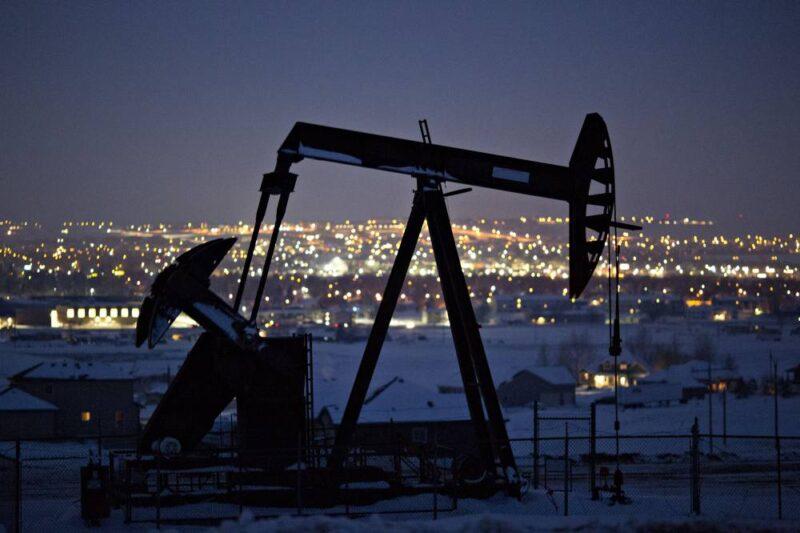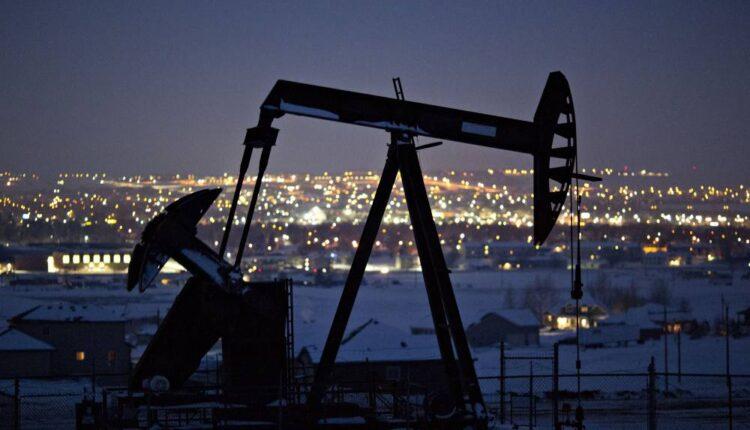
- The oil industry is in a crisis like it's never seen before, with the double edged sword of too much supply and a shocking drop in demand due to coronavirus shutdowns around the world.
- The U.S. market has been particularly hard hit by a glut of oil and not much storage left to put it in, and that helped start a wild plunge in the futures market Monday where one contract fell 300% into negative territory.
- "Producers are now being sent the harshest signal ever to react to the crisis," said one analyst.
A pumpjack operates above an oil well at night in the Bakken Formation on the outskirts of Williston, North Dakota, U.S., on Thursday, March 8, 2018. Bloomberg | Bloomberg | Getty Images
The oil industry is in its worst crisis since at least the Great Depression, according to analysts.
There's too much oil, and nobody wants to buy any more. Planes aren't flying, shipping has slowed, and U.S. consumers, who use 10% of the world's oil output in their cars, are now staying at home.
The action Monday in the most closely watched energy market in the world was devastating, as the value of the May oil futures contract plummeted 300 percent, flipping into negative territory to end at minus $37.63 per barrel. The price action was unprecedented, and hard to explain but it was also a wake up call for an industry that is likely to see much more pain ahead.
One reason the CME's May contract for West Texas Intermediate plunged was the well-understood.
There is simply a basic lack of storage capacity in the world for crude. As the contract expires, nobody wants to take delivery of the physical product. But that's not a satisfying explanation for such a bizarre price reaction, and there was speculation it was the result of hedging gone wrong or even some exchange traded funds behind the sell off.
The end result is that the industry now has had a warning that it needs to seriously curb drilling and unwinding the supply glut could be more difficult than expected. The May contract, which expires Tuesday, was the only one to trade in such erratic fashion, but the June contract was down 15% and was trading around $21.40 per barrel Monday afternoon. Brent futures, the international benchmark, were trading at about $25.90 per barrel.
But in the spot market, North American regional prices reflected the problems producers were having unloading landlocked crude in a market with no buyers. Oil in Cushing, Okla. was selling for a little over $5 a barrel but crude in the Bakken region in North Dakota was selling for negative $3 a barrel.
"The world has never come to a halt like it has in the past few weeks," said Francisco Blanch, global head of commodities at Bank of America. "60% of oil demand comes from transportation. Gasoline sales are down more than 50%. Flights around the world are down 80 or 90%. The collapse in consumption is mobility driven. That's what makes this crisis different than the great Depression."
Blanch said the normal market mechanism of consumers stepping in when prices fall is not working because of the virus shutdowns. "Producers are now being sent the harshest signal ever to react to the crisis," said Blanch.
Dan Yergin, vice chairman of IHS Markit, said there were two other times when WTI oil futures collapsed amid shortages of places to put it. But then prices fell to just under $10, and it was very different then.
"You ran out of storage and prices fell. The difference was in 1986 and 1998, demand was going up. This is with this demand collapse. We're on a planet we've never been on before.. This will end and demand will come back. A lot of it is up to public policy and a lot of it is up to the virus itself," says Yergin.
Just months ago, the American oil industry was on the top of the world. The price of oil was ticking up around $60 a barrel at the beginning of the year, and America was pumping more oil than any other country, surpassing both Russia and Saudi Arabia.
But the coronavirus outbreak in China overtook the good news story of an interim U.S.-China trade deal that would help global growth, and instead resulted in a steep drop in demand. The oil industry didn't stop pumping, and the world became more oversupplied with oil.
To make matters worse, Saudi Arabia and Russia failed to broker a new deal on oil production cuts , and as a result Saudi Arabia ramped up its production in March. They have since agreed to a new OPEC+ cut of 9.7 million barrels, but that is not expected to be enough to allow the world's oversupply to drain away.
"It's one thing to make a deal. It's another thing to find some place where you can still store oil," said Yergin. "The deal was meant to buy time, but buy time over a period of time. The deal doesn't magically solve what's happening today."
The deal was expected to begin in May, but Reuters reported from sources that Saudi Arabia would start sooner.
"This month is going to be a high tide of oil that's going to swamp storage. Storage was once a logistical tool, and now it's become a prized commodity," Yergin said. He said oil production reached its pinnacle at 13.1 million barrels a day in February, and he expects it to drop by 2.9 million barrels a day by the end of the year.
Yergin said it's been clear for awhile that the storage was running out and that by the end of April, there would be no where to put any crude.
Frail shale
The U.S. shale industry had grown up using ingenuity and technology to turn itself into the biggest producer in the world in less than two decades.
But now the industry is facing its worst financial stress ever.
"I think it's more flexible on one hand. On the other you are also going to lose a lot of capabilities in a relatively short order. You'll have to shut wells. They'll have to fire people. I think what it depends on is the pace of demand recovery," said Blanch.
Michael Bradley, managing director at Tudor Pickering Holt, said he thinks U.S. may have already cut production by close to 1 million barrels a day. He said companies like Conoco Philips and Continental have already said hey would shut in 25% to 30% of their production, and others will follow. But there will also be companies forced to shut down production.
"They're not producers that are over the barrel and are going to go into bankruptcy anytime soon. You're going to see multiple announcements by companies," said Bradley. "You had refinery runs down about 25% and probably going further," he said, adding production will follow those cutbacks.
"The quality names will survive," said Bradley "You probably have 25 or 30 % of the industry that is going to have to be restructured or go bankrupt in the next nine to 12 months."
Source: cnbc.com

